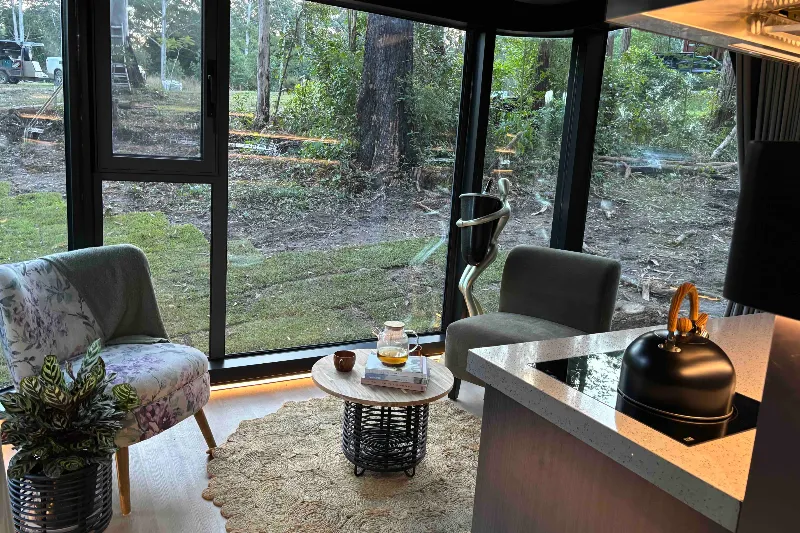Sign up to the Built Offsite Newsletter

Steve Phillips’ HALO model links relocatable modular housing with community-managed land access.
From New South Wales to Tasmania, interest is growing in a housing model that links durable modular construction with new pathways to land access. Developed by Steve Phillips, founder of Newcastle-based Rock Solid Construction, HALO—Housing Activated Through Land Opportunities—seeks to reframe how affordability, sustainability and community outcomes can work together in practice. (main image: Aluxria modular cabin suitable for HALO, a division of Rock Solid Construction.)

Phillips, who is Indigenous, brings more than four decades of construction experience to the table, along with a deep awareness of the relationship between people and Country that informs every project he takes on. “I’ve always been one to look at details,” he says. “That’s what led me into a niche market—building stone and timber homes, rammed earth, recycled material builds—things that were different and challenging.”
It’s this curiosity and willingness to explore alternatives that has shaped HALO’s direction. In its simplest form, HALO takes modular, transportable homes and pairs them with lease or community-managed land, sidestepping one of the biggest bottlenecks in housing supply.
“The affordability and accessibility for today’s youth—or anyone who can’t afford a $4 million beach house—has been my starting point,” Phillips says. “I looked at the housing market and worked out that you can’t fix anything unless you know what caused it.”

From building one-off homes to building a system
Phillips has seen the market from all angles: bespoke builds for high-end clients, intricate rural projects, and more recently, work that blends conventional craftsmanship with unconventional delivery methods.
“There’s a lot of vacant land—state-owned, Crown land, Aboriginal land, even under-used private land,” he says. “If we separate the house from the land and work on lease agreements or preferably community agreements, we can make housing affordable without waiting for conventional development timelines.”
At the core of HALO is Rock Solid’s transportable modular cabin—engineered with a galvanised structural steel frame, cyclone-rated to C1–4, and designed for multiple relocations.
“It has to last and it has to be strong,” Phillips says. “We went above and beyond—triple-glazed tempered glass, 100mm insulated walls, 150mm floor and ceiling insulation. They’re heavy because they’re built strong.”
Energy efficiency is a given, not an afterthought. “A two-bedroom model is around 76 square metres and under $200,000; a three-bedroom is about 126 square metres for up to $250,000. That’s very affordable,” he says.


Building to a budget without cutting corners
The cabins are currently produced in Linyi, China, to Rock Solid’s specifications. For Phillips, it’s the only way to hit the price point needed for his target market.
“I cannot build these in Australia for anywhere near the price I can bring them in for,” he says. “If I’m going to put people first—which means affordability—this is the path. However, my five-year plan is to build up to manufacturing here in Australia.”
HALO’s environmental footprint on site is deliberately light. Cabins are installed on screw piles or pads, leaving the ground intact. All infrastructure is permeable, and composting toilets—changed just twice a year—remove the need for costly sewer works.
“It’s about reducing what people have to earn to live well,” Phillips says. “If your home costs $150,000 to $250,000 instead of $750,000, you can get away with one income, work from home, and have time for gardening and family.”
Interest in the model is not limited to New South Wales. In Burnie, Tasmania, Mayor Kerry Graham, General Manager Simon Pitt and other local representatives have expressed interest in exploring how HALO could be adapted for their community—an early sign that the concept is resonating nationally as a practical response to housing pressures.
HALO as a catalyst
Phillips believes HALO can play a role in regional revitalisation, ESG-driven corporate projects and even farm regeneration. He’s in discussions with KEPCO, a South Korean energy company, about using surplus land in New South Wales for HALO villages linked to environmental repair.
“The agreement is that we then environmentally fix up the land,” he says. “It’s about multi-layering outcomes—social, environmental, economic.”
The model could also be a lifeline for small farms. “If a farmer can host five cabins under a community agreement, the residents contribute hours to farm work,” Phillips explains. “At some point, the farm starts making money again. The farmer always owns the land; the cabins are separate.”
While HALO is modular in form, Phillips’ vision reaches beyond housing. He talks about timber plantations, biochar production and regional hubs for manufacturing and innovation. “The housing is the hub of the country,” he says. “You heal the country and the country heals you.”
More than a product, a mindset
For Phillips, HALO isn’t a quick fix—it’s part of a long-term shift towards housing models that are financially, socially and environmentally sustainable. His connection to Country, both cultural and professional, underpins this approach.
“It’s not about ego,” he says. “It’s about providing something that’s quality, that’s going to last, that I’ve done my homework on. We’re lowering costs, keeping quality high, and opening doors to a better way of living.”